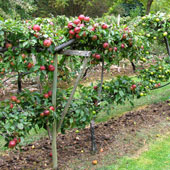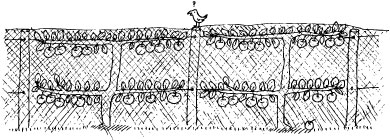No products
 View larger
View larger
Espaliering Made Easy (Horizontal T)
by Bob Magnus | © 2006 Woodbridge Fruit Trees | www.woodbridgefruittrees.com.au

Despite what the gardening media can imply, people who actually do produce their own food or part of it, know it is not a matter of skipping through the flower-dotted lawn to pick a perfect lettuce of a plump peach from a sweet little garden ringed with calendulas. The sweet little garden is more likely to be ringed with wire netting or electronic fencing to keep out the possums, wallabies or rabbits, often with netting over the top to exclude parrots, blackbirds, currawongs and silver-eyes. The feedback I get from friends and customers who buy my fruit trees is that it can be a battle to get trees to fruiting size and then a bigger battle to actually harvest the fruit!
Over the last 20 years I have developed a system whereby we can get most of our apples, pears and berries. It’s a system of growing dwarf fruit trees on espaliers where they are grown in an intensive way and can be easily covered by netting when needed. It’s not an original system, in fact, In Europe because shortage of suitable land and it’s hight cost many, or most orchards are now being grown in this manner.
Thirty years ago most apples and pears were meticulously pruned to vase shapes, often taking seven or eight years to start production. Today the imperative is to get he trees bearing as soon as possible, preferably in their second year, and it is not the amount of fruit per tree that counts, but how much can be obtained per hectare that is important. In short, there has been a revolution in the cultivation techniques of orchards throughout the world. Many purists and nostalgists are very scathing about this development, but it suits very much the needs of many people who live in rural Australia, often with bush close by and lots of wildlife to contend with.
This system firstly depends on growing small trees on wires, known as espaliering. When you mention espaliers to just about any intending fruit growers, they look at you in stunned disbelief and quietly change the subject. There are many very erudite and complex books on this subject in just about every local library and they leave you with a feeling of total disorientation and confusion, but it is not really like that, it’s easy! All you need is a sense of adventure and the willingness to try, and of course the trait that identifies the gardener – patience. After all, what’s another year but four seasons in the garden?
Espaliering Sequence
OK, so down to business. The infrastructure is a trellis, actually three trellises, each ten metres long with post at two metre intervals and two metres tall above the ground.
There are any amount of different materials you can use: treated pine, hard-wood, steel picket-type stakes, old galvanised pipes etc. For the horizontals, you would probably use wire, but my cherries and grapes both have wooden (sawmill off cuts) horizontals and that’s fine.

1.The whole infrastructure should be firm, but it is not necessary to outlay a fortune. When the trees grow, they become quite self-supporting.Two wires are stretched between the uprights to approximately 90cm and 180cm in height.There are systems with lots more wires but I find that two are quite adequate.The little trees are planted in between the posts and cut off below the bottom wire.

2.In the first year, these little trees with suitable attention should put out some good growth like this.That is, if there is no competition from weeds and grasses, no errant whipper-snippers, adequate mulch, fertiliser and water (but not too much!), should put out some good growth like this.

3. All growth except the two strongest shoots is cut away and these are tied down to the bottom of the wire in winter.

4.At the end of the second year, things should look a bit like this.

5.The tips are tied down again ad all growth cut away except the one upright that will grow up to the top wire.

6.In subsequent years, the process is repeated: the tips are tied down and the upright growth cut away.

7.After about five years things should look a bit like this using a 2 wire system. You can use 3 or 4 levels if you wish.

8.When the fruit starts to mature it is easy to cut away the young upright growth on the top row and cover the lot with a net.
The system is very flexible, each tree and each variety has its own vigour. In time the varieties may grow into each other. You just have to watch and observe. If you’re a bit of a shortie, you may prefer to put the bottom wire at 60cm and the top one at 1.5m. If you are really tall, you may go for 1.1m and 2m. I find two metres apart is about the optimum for my dwarf trees, however you could plant them much closer and let them overlap and grow into each other. If you wanted to use normal apples and pears on vigorous understocks, the distance apart and height would have to be much greater generally to compensate for the natural growth habit of much larger trees.
Try three rows, with five trees each. Why? Well, each row represents different ripening times. The first row is of trees ripening in January and February, the second row are mid-season varieties and the third row is for the late ones. Below are lists of varieties that would fit into each category. Again, there is a lot of flexibility here. If you have a huge family and make a lot of cider and pies, you may wish to have a row of 10 earlies, 10 mids and 10 lates. Or if you were a little old couple, maybe two of each would be sufficient. If you keep equal numbers in each row and plant according to ripening, you will only have to buy one net. When you have picked the earlies, move the net on to the late ones. Our nets are 10 years old and should last a good while yet.
Also, this system lends itself perfectly to drip irrigation. Even in the most arid areas you shouldn’t suffer from lack of water. Along the bottom wire 12mm of black polypipe is hooked on and a dripper inserted just above each tree. I find the absolute minimum dripper, say one litre per hour is quite adequate. With an efficient modern filter you can even use grey water and an absolute minimum of pressure is required. Pipes and water lines are off the ground away from mowers and whipper snippers. As the trees grow, the original dripper can be blocked up and two drippers inserted about 30cm away on either side of the main trunk.
So, before you plant your next orchard, think about it! It works well for us and it may do for you.
This product is no longer in stock
by Bob Magnus | © 2006 Woodbridge Fruit Trees | www.woodbridgefruittrees.com.au

Despite what the gardening media can imply, people who actually do produce their own food or part of it, know it is not a matter of skipping through the flower-dotted lawn to pick a perfect lettuce of a plump peach from a sweet little garden ringed with calendulas. The sweet little garden is more likely to be ringed with wire netting or electronic fencing to keep out the possums, wallabies or rabbits, often with netting over the top to exclude parrots, blackbirds, currawongs and silver-eyes. The feedback I get from friends and customers who buy my fruit trees is that it can be a battle to get trees to fruiting size and then a bigger battle to actually harvest the fruit!
Over the last 20 years I have developed a system whereby we can get most of our apples, pears and berries. It’s a system of growing dwarf fruit trees on espaliers where they are grown in an intensive way and can be easily covered by netting when needed. It’s not an original system, in fact, In Europe because shortage of suitable land and it’s hight cost many, or most orchards are now being grown in this manner.
Thirty years ago most apples and pears were meticulously pruned to vase shapes, often taking seven or eight years to start production. Today the imperative is to get he trees bearing as soon as possible, preferably in their second year, and it is not the amount of fruit per tree that counts, but how much can be obtained per hectare that is important. In short, there has been a revolution in the cultivation techniques of orchards throughout the world. Many purists and nostalgists are very scathing about this development, but it suits very much the needs of many people who live in rural Australia, often with bush close by and lots of wildlife to contend with.
This system firstly depends on growing small trees on wires, known as espaliering. When you mention espaliers to just about any intending fruit growers, they look at you in stunned disbelief and quietly change the subject. There are many very erudite and complex books on this subject in just about every local library and they leave you with a feeling of total disorientation and confusion, but it is not really like that, it’s easy! All you need is a sense of adventure and the willingness to try, and of course the trait that identifies the gardener – patience. After all, what’s another year but four seasons in the garden?
Espaliering Sequence
OK, so down to business. The infrastructure is a trellis, actually three trellises, each ten metres long with post at two metre intervals and two metres tall above the ground.
There are any amount of different materials you can use: treated pine, hard-wood, steel picket-type stakes, old galvanised pipes etc. For the horizontals, you would probably use wire, but my cherries and grapes both have wooden (sawmill off cuts) horizontals and that’s fine.

1.The whole infrastructure should be firm, but it is not necessary to outlay a fortune. When the trees grow, they become quite self-supporting.Two wires are stretched between the uprights to approximately 90cm and 180cm in height.There are systems with lots more wires but I find that two are quite adequate.The little trees are planted in between the posts and cut off below the bottom wire.

2.In the first year, these little trees with suitable attention should put out some good growth like this.That is, if there is no competition from weeds and grasses, no errant whipper-snippers, adequate mulch, fertiliser and water (but not too much!), should put out some good growth like this.

3. All growth except the two strongest shoots is cut away and these are tied down to the bottom of the wire in winter.

4.At the end of the second year, things should look a bit like this.

5.The tips are tied down again ad all growth cut away except the one upright that will grow up to the top wire.

6.In subsequent years, the process is repeated: the tips are tied down and the upright growth cut away.

7.After about five years things should look a bit like this using a 2 wire system. You can use 3 or 4 levels if you wish.

8.When the fruit starts to mature it is easy to cut away the young upright growth on the top row and cover the lot with a net.
The system is very flexible, each tree and each variety has its own vigour. In time the varieties may grow into each other. You just have to watch and observe. If you’re a bit of a shortie, you may prefer to put the bottom wire at 60cm and the top one at 1.5m. If you are really tall, you may go for 1.1m and 2m. I find two metres apart is about the optimum for my dwarf trees, however you could plant them much closer and let them overlap and grow into each other. If you wanted to use normal apples and pears on vigorous understocks, the distance apart and height would have to be much greater generally to compensate for the natural growth habit of much larger trees.
Try three rows, with five trees each. Why? Well, each row represents different ripening times. The first row is of trees ripening in January and February, the second row are mid-season varieties and the third row is for the late ones. Below are lists of varieties that would fit into each category. Again, there is a lot of flexibility here. If you have a huge family and make a lot of cider and pies, you may wish to have a row of 10 earlies, 10 mids and 10 lates. Or if you were a little old couple, maybe two of each would be sufficient. If you keep equal numbers in each row and plant according to ripening, you will only have to buy one net. When you have picked the earlies, move the net on to the late ones. Our nets are 10 years old and should last a good while yet.
Also, this system lends itself perfectly to drip irrigation. Even in the most arid areas you shouldn’t suffer from lack of water. Along the bottom wire 12mm of black polypipe is hooked on and a dripper inserted just above each tree. I find the absolute minimum dripper, say one litre per hour is quite adequate. With an efficient modern filter you can even use grey water and an absolute minimum of pressure is required. Pipes and water lines are off the ground away from mowers and whipper snippers. As the trees grow, the original dripper can be blocked up and two drippers inserted about 30cm away on either side of the main trunk.
So, before you plant your next orchard, think about it! It works well for us and it may do for you.
Reviews
No customer reviews for the moment.

